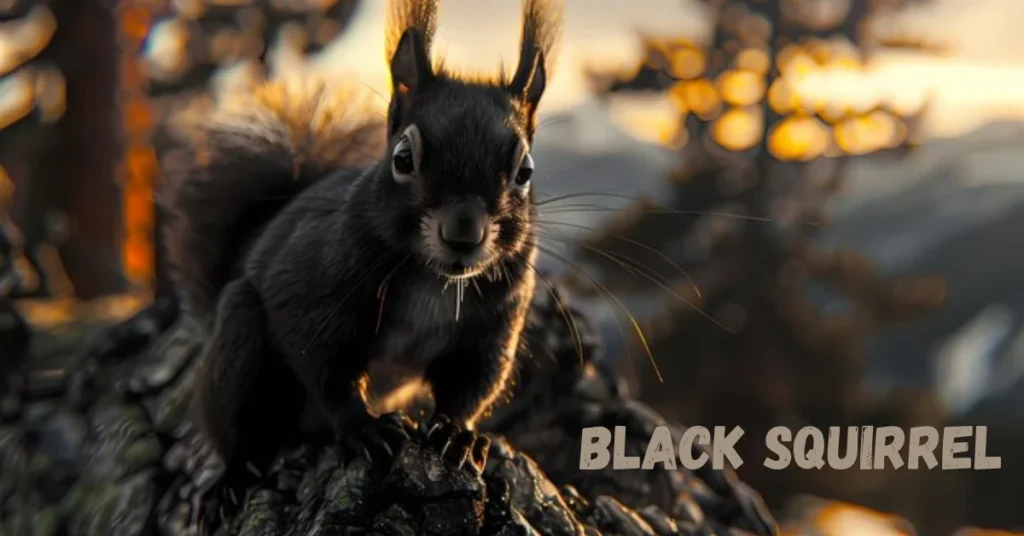Introduction to Black Squirrels
Have you ever spotted a black squirrel darting through the trees, its sleek fur contrasting against the vibrant greens of nature? If so, you’re not alone. These charming creatures have captivated wildlife enthusiasts and casual observers alike with their unique appearance and playful antics. Black squirrels are more than just a variation of the common gray squirrel; they boast an intriguing history, fascinating characteristics, and even some myths that swirl around them. As we take a closer look at these remarkable animals, prepare to be enchanted by their stories and insights into their lives in our shared world.
The Origin and History of Black Squirrels
The black squirrel, a striking variant of the common gray squirrel, has intrigued many with its unique coloring. This fascinating creature is thought to have originated from genetic mutations that produced darker fur in certain populations.
Historically, these squirrels were first documented in North America during the 18th century. They likely emerged as adaptations to specific environments where their darker coats provided better camouflage against predators.
Interestingly, black squirrels are also found in places beyond North America. Their presence can be traced back to Europe and parts of Asia, showcasing a broader geographical history than one might expect.
Due to selective breeding and urbanization, sightings of black squirrels became more frequent over time. Today, they inhabit parks and residential areas across various regions, captivating those lucky enough to spot them amidst the trees.
Unique Characteristics of Black Squirrels
Black squirrels boast a striking appearance that sets them apart from their gray and red counterparts. Their glossy, jet-black fur can vary in shade, sometimes appearing almost chocolatey under the right light.
These creatures are slightly larger than typical eastern gray squirrels. With bushy tails and agile bodies, they navigate trees with remarkable grace. Their size aids in storing food for winter; they often bury nuts deep underground.
What’s fascinating is their genetic makeup. The black coloration results from a melanistic gene, which offers some advantages like better camouflage at night and protection against certain predators.
Their eyes shine brightly against the dark fur, giving them an alert expression. Black squirrels are equally adept climbers, often seen leaping between branches with ease and confidence. This dexterity makes them mesmerizing to watch in action as they defy gravity amidst towering trees.
Myths and Misconceptions Surrounding Black Squirrels
Many myths surround the enigmatic black squirrel, often leading to confusion. One common belief is that black squirrels are a separate species. In reality, they are simply a color variation of the Eastern gray squirrel.
Another misconception suggests that black squirrels are more aggressive or territorial than their lighter counterparts. Research shows this isn’t true; behavior largely depends on individual circumstances rather than fur color.
Some people think black squirrels bring bad luck or signify impending weather changes. Such superstitions lack scientific backing and stem from cultural folklore rather than factual evidence.
There’s an idea that observing a black squirrel means you’ll have financial prosperity soon. While it’s fun to entertain these notions, they remain rooted in myth rather than truth. Understanding the facts about these unique creatures can foster appreciation instead of fear or misunderstanding.
Habitat and Distribution of Black Squirrels
Black squirrels thrive in a variety of habitats, primarily favoring deciduous and mixed forests. These environments provide ample food sources and nesting opportunities. They are often found in urban parks, where trees abound and human presence is minimal.
These fascinating creatures have adapted well to suburban areas too. Their ability to navigate both rural landscapes and populated cities showcases their versatility. Black squirrels are commonly spotted across North America, particularly in the eastern regions.
Interestingly, their distribution extends into Canada as well. Certain states like Michigan and Ohio report notable populations of black squirrels. The contrast between their dark fur and the vibrant greens of their surroundings makes them stand out beautifully.
This adaptability allows them to flourish in diverse climates while maintaining a healthy population. Observing black squirrels scurrying through various landscapes adds a unique charm to our natural world.
Interactions with Humans and Other Animals
Black squirrels often find themselves navigating the urban jungle alongside humans. Their dark, glossy fur makes them stand out against city landscapes. Many people enjoy spotting these lively creatures darting through parks and backyards.
Curious by nature, black squirrels can be quite bold around humans. They might approach if food is involved, showing little fear of our presence. This behavior prompts many to feed them snacks like nuts or seeds, creating a unique bond between species.
In the wild, interactions with other animals vary dramatically. While they share habitats with gray squirrels and chipmunks, competition for food can lead to squabbles among them. Black squirrels are also known to evade predators like hawks and foxes through their agility and speed.
Their adaptability allows them to thrive in diverse environments while maintaining complex social dynamics within their surroundings. Each encounter contributes to the ongoing narrative of their existence amidst both human life and wildlife challenges.
Conservation Efforts for Black Squirrels
Conservation efforts for black squirrels are gaining momentum in various regions. Organizations and wildlife groups work tirelessly to ensure these unique creatures thrive.
Habitat protection is a primary focus. Preserving urban parks, forests, and green spaces allows black squirrels to flourish. These areas provide shelter, food sources, and safe pathways for movement.
Community engagement plays a vital role as well. Educational programs raise awareness about the importance of preserving local wildlife populations. Residents learn how their actions can impact black squirrel habitats significantly.
Research initiatives help monitor population trends and health indicators among black squirrels. Scientists study their genetics to understand better the factors affecting their survival rates.
Volunteers often participate in tree planting events or habitat restoration projects aimed at enhancing environments conducive to the needs of black squirrels. Engaging local communities fosters a sense of stewardship towards these fascinating animals, ensuring they remain part of our ecosystems for generations to come.
Conclusion: Embracing the Beauty of Black Squirrels
Black squirrels are captivating creatures that add a unique flair to our natural surroundings. Their striking appearance and intriguing behaviors invite us to take a closer look. By understanding their origins, characteristics, and ecological importance, we can appreciate these animals more deeply.
As they navigate the urban landscapes and forests alike, black squirrels remind us of nature’s adaptability. With proper conservation efforts in place, we ensure future generations will also get to experience the charm of these fascinating animals.
Let’s continue to embrace the beauty of black squirrels in our communities and support initiatives that protect their habitats. After all, every little effort counts when it comes to preserving wildlife for everyone to enjoy.
FAQs
What is a black squirrel?
A black squirrel is a melanistic variant of the common gray squirrel, known for its sleek, dark fur. It’s not a separate species but a color mutation, often seen in urban and suburban areas.
Where can black squirrels be found?
Black squirrels are commonly found in North America, especially in eastern regions like Michigan and Ohio. They also inhabit parts of Canada, Europe, and Asia.
Are black squirrels more aggressive than gray squirrels?
No, black squirrels are not more aggressive. Behavior is influenced by individual circumstances, not fur color, and they are just as social as gray squirrels.
Do black squirrels bring bad luck?
No, the idea that black squirrels bring bad luck is a myth. Such superstitions are based on cultural folklore rather than scientific evidence.
How do black squirrels adapt to urban environments?
Black squirrels are highly adaptable, thriving in urban parks and residential areas. Their ability to navigate both natural and city landscapes allows them to coexist with humans and other animals easily.







